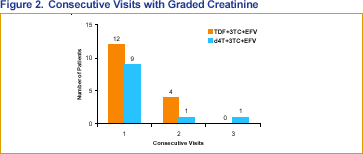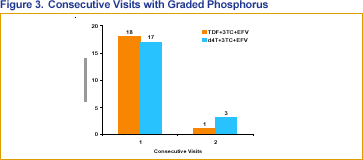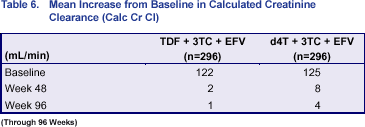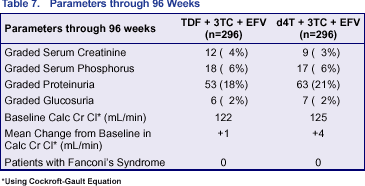 |
 |
 |
| |
|
Similar 96-wk Renal Safety Profile of Tenofovir vs d4T: used in combination with 3TC/efavirenz in treatment-naïve patients
|
| |
| |
Reported by Jules Levin
Study 903 is an ongoing 144 week, randomized, double-blinded, international multicenter trial which compares TDF and d4T when used in combination with EFV and 3TC in 600 ART naïve patients. Both regimens were very potent in suppressing HIV as evaluated by percent of undetectable viral load. When comparing effects of the two regimens on hypertriglyecidemia, body changes, and neuropathy, tenofovir (TDF) showed favorable results compared to the d4T regimen. This poster takes a look at parameters of renal toxicity for both regimens in the study through 96 weeks of the study. Recent data regarding bone effects of the two regimens in this study were made available and are in a revised FDA label for TDF. You can read this information in the new NATAP newsletter just off the press and posted in pdf format on the NATAP website (Positive Reports, 9/15/03). To receive a printed version of the new edition of this HIV newsletter and the new edition of the NATAP Hepatitis Review newsletter (also posted in pdf) on the NATAP website) please call NATAP at 212 219-0106 (toll free 888-26-natap).
Patients with serum creatinine <1.5 mg/dl, serum phosphorous >2.1 mg/dl, and calculated creatinine clearance >59 mL/min were excluded from the study. Mean age of patients in the study is 36; weight 72 kg; 26% female; 64% white, 18-21% black, 7% hispanic, 1% asian.
Joel Gallant and colleagues (poster abst. H-840) assessed several renal parameters for both groups: serum creatinine, serum phosphorus, proteinuria, glucosuria and mean change from baseline in calculated creatinine clearance. Gallant reported that the renal safety profile was similar between the patients receiving TDF or d4T plus 3TC/EFV through 96 weeks. No patients discontinued the study due to TDF related renal abnormalities and no patient developed Fanconi’s Syndrome through 96 weeks.
Some patients with underlying renal concerns, taking nephrotoxic drugs, and other conditions may be at additional risk for renal toxicities and need to be monitored properly. In patients with renal insufficiency, the pharmacokinetics of tenofovir can change. Patients with creatinine clearance of less than 50 mL/min have to reduce TDF dose.
RESULTS
|
|
| |
| |
 |
|
| |
| |
 |
|
| |
| |
 |
|
| |
| |
 |
|
| |
| |
 |
|
| |
| |
 |
|
| |
| |
 |
|
| |
| |
 |
|
| |
|
 |
 |
|
|